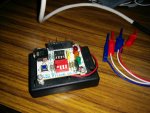Hello All ....first time on the forum.
I have some time on my hands and would like to begin learning Basic so that I can build some electronic gizmos.
I think I've settled on using the Picaxe chip and some kind of board to plug it into.
I'll have some questions from time to time so I'm glad to know that a forum of Picaxe gurus exists.
Here are a couple now.
Thanks for letting me know what you think.
1.)Given that there are hundreds of Basic dialects....which one should I learn....that would be acceptable for electronic projects?
2.)Does the Picaxe use one kind of Basic programming language in particular...?
3.) Can I put the picaxe in ANY board....once I write to it?.....or should I stay with the Picaxe boards only?
4.) Will the Picaxe chip be capable of say......running servos, and cameras, etc. for say....a homemade drone, or to control the H20 temp (valve openings, etc) in my solar hot tub?
Which Basic dialect would you choose ......
I wrote a Basic program to the TRS-80 back in the 80's but have forgotten how I did it....
I could plug in pipe diameters and lengths of pipe to determine if.... when capped off on both ends whether it would bouy up (float) a desired weight....
So there's that.
D.
I have some time on my hands and would like to begin learning Basic so that I can build some electronic gizmos.
I think I've settled on using the Picaxe chip and some kind of board to plug it into.
I'll have some questions from time to time so I'm glad to know that a forum of Picaxe gurus exists.
Here are a couple now.
Thanks for letting me know what you think.
1.)Given that there are hundreds of Basic dialects....which one should I learn....that would be acceptable for electronic projects?
2.)Does the Picaxe use one kind of Basic programming language in particular...?
3.) Can I put the picaxe in ANY board....once I write to it?.....or should I stay with the Picaxe boards only?
4.) Will the Picaxe chip be capable of say......running servos, and cameras, etc. for say....a homemade drone, or to control the H20 temp (valve openings, etc) in my solar hot tub?
Which Basic dialect would you choose ......
I wrote a Basic program to the TRS-80 back in the 80's but have forgotten how I did it....
I could plug in pipe diameters and lengths of pipe to determine if.... when capped off on both ends whether it would bouy up (float) a desired weight....
So there's that.
D.

